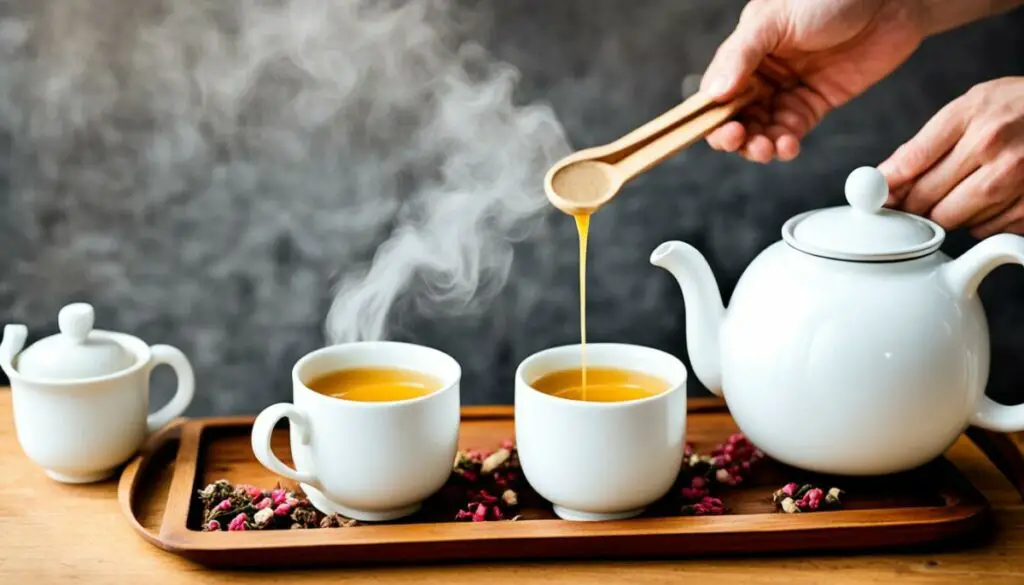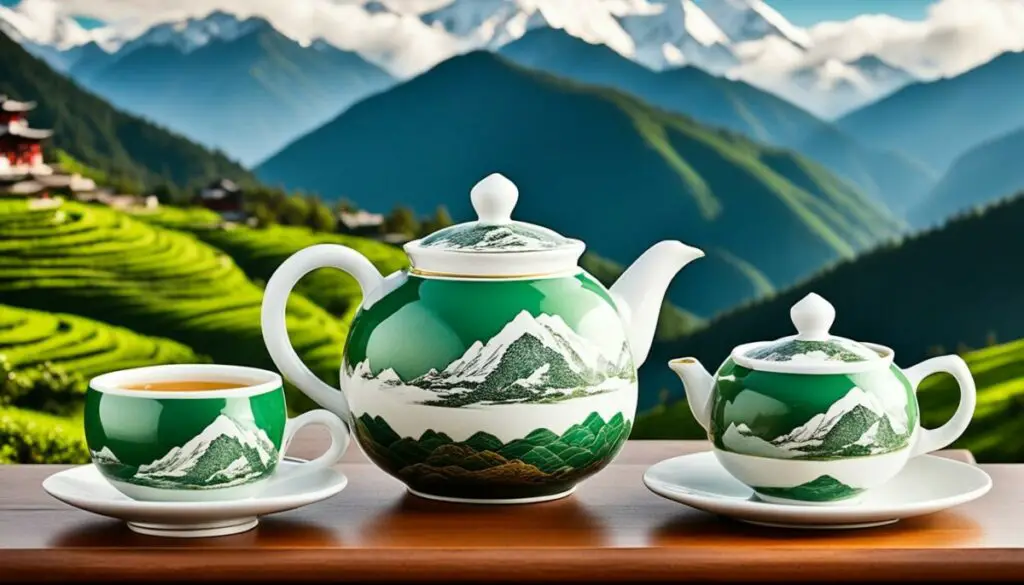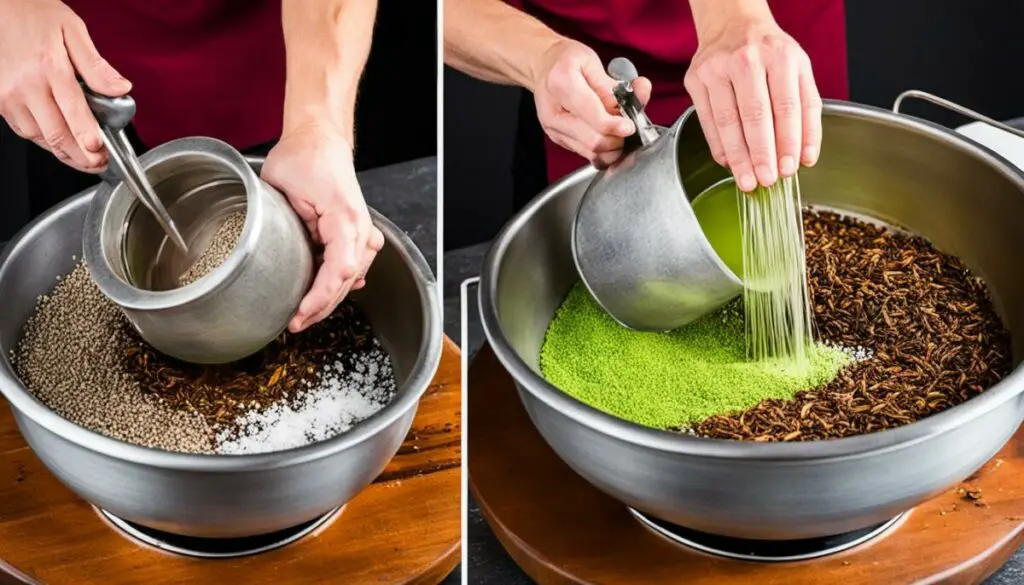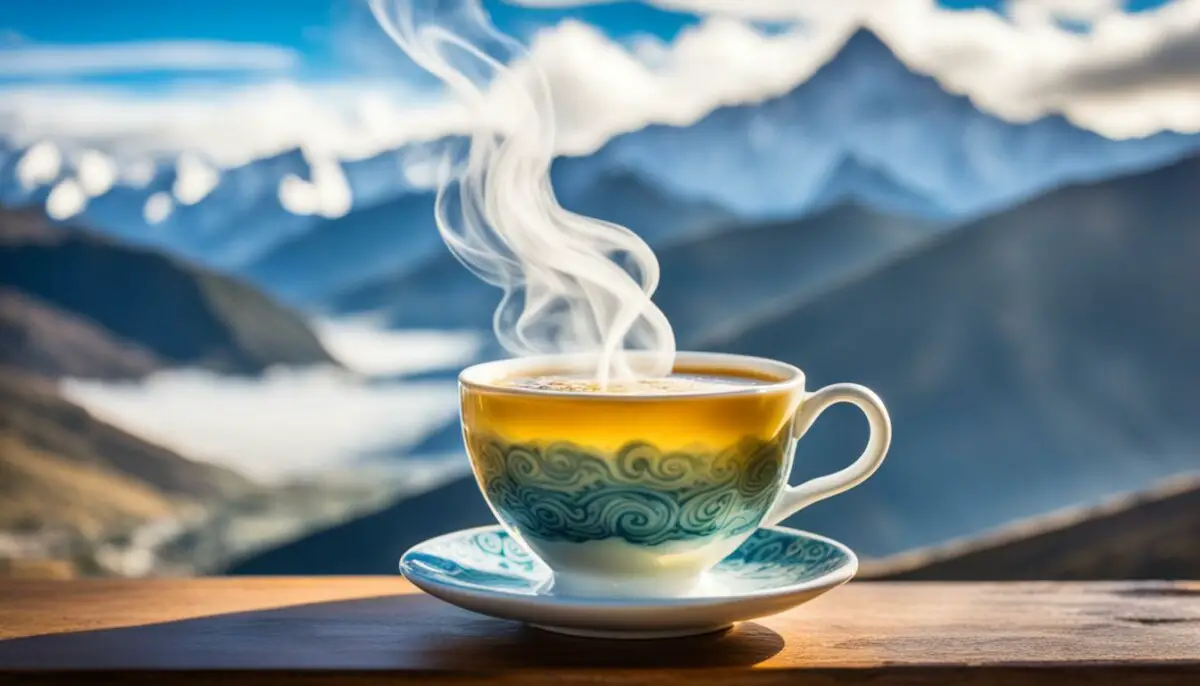Last Updated on 3 months by Francis
If you’re looking for a unique and flavorful tea experience, look no further than Po Cha, the traditional Tibetan butter tea. Not only is Po Cha a staple in Tibetan culture, but it’s also known for its potential health benefits, such as aiding digestion and providing energy. Whether you’re a tea lover or simply curious about different cultural beverages, Po Cha is sure to leave a lasting impression.
Key Takeaways:
- Po Cha is a traditional Tibetan butter tea known for its unique flavor profile.
- It is made by mixing brewed tea with butter, salt, and sometimes milk or yak milk.
- Po Cha has a long history and is enjoyed during social gatherings and religious ceremonies.
- The tea used in Po Cha is typically a strong black tea like Assam or Darjeeling.
- Po Cha has potential health benefits, including aiding digestion and providing an energy boost.
Contents
The Tradition and Flavor of Po Cha

Po Cha is a traditional Tibetan beverage that holds a significant place in Tibetan tea culture. Made by mixing brewed tea with butter, salt, and sometimes milk or yak milk, Po Cha offers a unique and distinct flavor profile. It can be described as rich, salty, and slightly bitter, providing a taste that is unlike any other tea.
Also known as cha süma in Ladakh and suja in Bhutan, Po Cha has deep roots in Tibetan traditions. It is often enjoyed during social gatherings, religious ceremonies, or as a warm welcome for guests. The preparation of Po Cha remains consistent across different regions, with slight variations in the ingredients used. Some variations may include the addition of ginger or cardamom to enhance the flavor.
“Po Cha is not just a beverage; it is a symbol of hospitality and the warm Tibetan tea culture.”
The tradition of Po Cha has been passed down through generations, and the art of making this traditional Tibetan butter tea holds a special place in Tibetan society. It is not just a beverage; it is a symbol of hospitality and the warm Tibetan tea culture that has been cherished for centuries.
Here’s a simple step-by-step guide on how to make Po Cha:
- Boil tea leaves in water to create a concentrated brew.
- Strain the tea leaves and add butter and salt to the hot tea until fully dissolved.
- Optional: Add milk or yak milk to the mixture and heat until hot.
- Serve the Po Cha in small bowls or cups immediately.
Feel free to adjust the ingredients and proportions according to your taste preferences.
The image above depicts the traditional Tibetan butter tea, also known as Po Cha.
The Origins of Po Cha

The exact origins of Po Cha are unclear, but it is believed to have originated in Tibet over a thousand years ago. Po Cha has a rich history deeply intertwined with Tibetan culture and traditions, making it a significant beverage in the region.
One theory suggests that Po Cha was created by Tibetan nomads as a way to sustain themselves in the harsh climate of the Tibetan Plateau. The combination of tea, butter, and salt provided the necessary energy and warmth needed to endure the extreme conditions.
Another theory proposes that Po Cha was introduced to Tibet from neighboring regions, such as China or Nepal, where similar tea with butter concoctions were already popular.
Regardless of its specific origins, Po Cha has become an integral part of Tibetan culture, closely associated with hospitality and friendship. It is commonly served during social gatherings, religious ceremonies, and to welcome guests, symbolizing the warmth and generosity of the Tibetan people.
The Tea Used in Po Cha
In Po Cha, a strong black tea is traditionally used. The tea leaves are boiled to create a concentrated brew, which is then mixed with butter, salt, and sometimes milk or yak milk. The type of tea can vary depending on availability and personal preference, but robust varieties like Assam or Darjeeling are commonly used. The tea needs to withstand the strong flavors of the other ingredients and provide a rich base for the traditional Tibetan butter tea.
A Variety of Black Teas
| Type of Tea | Description |
|---|---|
| Assam Tea | A full-bodied tea with a malty flavor, Assam tea adds depth to Po Cha and enhances its richness. |
| Darjeeling Tea | Famously known as the “Champagne of teas,” Darjeeling tea lends floral and muscatel notes to Po Cha, balancing the savory flavors with its delicate taste. |
These black teas provide a robust base to complement the bold flavors of Po Cha, ensuring a harmonious blend of tastes. The concentrated brew created by boiling the tea leaves allows it to hold its own against the butter, salt, and other ingredients, resulting in a unique and satisfying tea experience.
Potential Health Benefits of Po Cha

Po Cha, the traditional Tibetan butter tea, offers more than just a unique and flavorful taste. It also has potential health benefits that make it even more appealing. Let’s take a closer look at some of the health benefits of Po Cha:
1. Energy Boost
The high fat and calorie content in Po Cha can provide an instant energy boost. This makes it a popular choice among those who need a quick pick-me-up, especially in the cold Tibetan climate. The combination of butter and tea creates a rich and sustaining beverage that can help fuel your day.
2. Digestive Aid
Drinking Po Cha with a meal can aid in digestion. The warm beverage stimulates the digestive system, helping to break down food more efficiently. The traditional recipe with butter and salt contributes to the digestive process, making it easier for your body to absorb nutrients and prevent discomfort.
3. Anti-Inflammatory Properties
Po Cha contains ingredients that possess anti-inflammatory properties. The tea leaves and butter used in Po Cha are known for their potential to reduce inflammation in the body. This can be particularly beneficial for individuals with conditions such as arthritis or digestive issues caused by inflammation.
4. Hydration in High-Altitude Regions
Hydration is essential, especially in high-altitude regions where the air is drier. Po Cha can help with hydration due to its liquid content. While it’s not a substitute for water, drinking Po Cha can contribute to your overall hydration needs, keeping you refreshed and hydrated in challenging environments.
It’s important to note that while Po Cha has potential health benefits, it is also high in calories, salt, and saturated fat. Therefore, it should be consumed in moderation, taking into consideration individual dietary needs and health conditions.
| Health Benefit | Description |
|---|---|
| Energy Boost | Provides an instant energy boost due to its high fat and calorie content. |
| Digestive Aid | Aids in digestion when consumed with a meal, thanks to its warm and soothing properties. |
| Anti-Inflammatory Properties | Contains ingredients that may help reduce inflammation in the body, benefiting individuals with inflammatory conditions. |
| Hydration in High-Altitude Regions | Contributes to hydration needs, particularly in dry and high-altitude environments. |
While enjoying the delicious and unique taste of Po Cha, you can also reap its potential health benefits. Just remember to consume it in moderation and be mindful of your individual dietary needs. Cheers to your well-being!
Caffeine Levels in Po Cha

Po Cha, the traditional Tibetan butter tea, packs a significant punch of caffeine. This is due to its use of black tea, which is known for its higher caffeine content compared to other tea varieties. While the exact amount of caffeine can vary, Po Cha generally contains more caffeine than regular tea.
Caffeine is a natural stimulant that can provide an energy boost, helping you stay alert and focused. However, it’s important to be mindful of individual tolerance and potential side effects of excessive caffeine consumption. Some people may be more sensitive to the effects of caffeine, experiencing jitters, irritability, or difficulty sleeping when consuming too much.
In moderation, the caffeine content in Po Cha can provide a pleasant and energizing experience. Just be sure to listen to your body and consume Po Cha responsibly.
Note: The image above depicts the beautiful process of preparing Po Cha.
The Taste of Po Cha

Po Cha has a unique and distinct taste that may take some getting used to for those unfamiliar with it. The flavor can be described as rich, savory, and slightly salty, with a creamy texture from the butter and milk. It’s an acquired taste that is appreciated by those who enjoy the complex and flavorful combination of ingredients. Po Cha is an important part of Tibetan culture and tradition, often served as a symbol of hospitality and friendship.
When you take your first sip of Po Cha, you’ll be greeted with a robust and full-bodied flavor. The combination of brewed black tea, butter, and salt creates a unique profile that tantalizes the taste buds. The rich, savory taste is complemented by a hint of saltiness, adding depth and complexity to the overall experience.
The creaminess of the butter and milk adds a velvety texture, enhancing the drinking experience. As you savor each sip, you’ll appreciate the creamy mouthfeel that coats your palate. The flavors linger, leaving behind a satisfying aftertaste that is both comforting and memorable.
While Po Cha may be an acquired taste, its rich and savory flavor has made it a beloved beverage in Tibetan culture. It is often enjoyed during social gatherings, religious ceremonies, or simply as a warm beverage to welcome guests. The flavor of Po Cha is a testament to the centuries-old tradition and craftsmanship that goes into its preparation.
Other Types of Tea in Tibet

In addition to Po Cha, Tibet offers a variety of other tea options that are commonly served and enjoyed. Each type of tea has its own unique flavors and characteristics, adding to the vibrant tea culture of the region. Let’s explore some of the popular alternatives to Po Cha:
Sweet Milk Tea
Sweet milk tea is a delightful variation of butter tea that combines black tea, milk, and sugar. It offers a creamy and slightly sweet taste, making it a beloved choice for those who prefer a milder flavor. Sweet milk tea is often enjoyed as a comforting and soothing beverage.
Tibetan Herbal Tea
Tibetan herbal tea is a blend of medicinal herbs and spices, carefully crafted to not only delight the taste buds but also offer potential health benefits. This aromatic and flavorful tea is believed to have properties that promote wellness and balance. Tibetan herbal tea is commonly consumed for its soothing and rejuvenating qualities.
Salted Butter Tea
Salted butter tea is a variation of Po Cha where milk is omitted, resulting in a strong and savory flavor. This robust tea is made by blending brewed tea with butter and salt, creating a rich and energizing beverage. Salted butter tea is known for its intense and satisfying taste, cherished by those seeking a bold tea experience.
Green Tea
While less common than Po Cha, green tea is also enjoyed in Tibet. This refreshing and invigorating tea is typically served alongside meals or as a cooling drink during hot weather. Green tea offers a delicate and subtle flavor, admired for its lightness and natural goodness.
These teas provide a delightful array of choices for those looking to explore the diverse flavors of Tibet. Whether you prefer the creamy sweetness of sweet milk tea or the robust savoriness of salted butter tea, there is a tea option to suit every palate and preference.
In the next section, we will guide you through the step-by-step process of making Po Cha, allowing you to savor this unique tea experience in the comfort of your own home.
Making Po Cha: Step-by-Step Guide

Are you ready to embark on a culinary adventure and make your own Po Cha? Follow this step-by-step guide to create a delicious cup of traditional Tibetan butter tea right in your own kitchen.
Ingredients
- Brewed tea
- Butter
- Salt
- Optional: Milk or Yak milk
Instructions
- Start by boiling the tea leaves in water to create a concentrated brew.
- Once brewed, strain the tea to remove any leaves or particles.
- Add butter and salt to the brewed tea and stir until fully dissolved.
- If desired, you can also add milk or yak milk to the mixture for added richness and creaminess.
- Heat the Po Cha mixture until hot, but be careful not to boil it.
- Once heated, serve the Po Cha in small bowls or cups immediately.
Traditional Po Cha is often topped with a pinch of roasted barley flour for an extra burst of flavor.
Adjust the ingredients to suit your taste preferences. Some people prefer a stronger tea flavor, while others enjoy a more buttery and savory taste. Experiment and find the perfect balance for your own version of Po Cha.
Now that you know the secret to making Po Cha, it’s time to savor this unique and culturally significant Tibetan butter tea. Enjoy it on its own or pair it with your favorite traditional Tibetan snacks for a truly authentic experience.
Health Benefits of Tibetan Tea
Tibetan tea, including Po Cha, offers a range of potential health benefits that make it more than just a delightful beverage. Here are some ways in which Tibetan tea can positively impact your well-being:
Weight Loss
Tibetan tea can aid in weight loss by boosting metabolism and promoting fat burning. Its natural properties increase the body’s calorie expenditure, helping you shed those extra pounds. Incorporating Tibetan tea into your weight loss journey can provide an additional boost to your efforts.
Cancer Prevention
The antioxidants present in Tibetan tea, such as catechins and polyphenols, have been linked to cancer prevention. These powerful compounds help combat free radicals in the body, reducing the risk of cellular damage and the development of cancer. By enjoying Tibetan tea regularly, you can give your body a natural defense against this prevalent disease.
Cardiovascular Health
Tibetan tea contributes to cardiovascular health by lowering blood pressure, reducing cholesterol levels, and minimizing the risk of blood clots. Regular consumption of Tibetan tea can support a healthy heart and promote overall cardiovascular well-being. This is particularly beneficial for individuals with a predisposition to heart-related conditions.
Improved Digestion
The unique compounds found in Tibetan tea can aid digestion, supporting a healthy gut and improving overall digestive function. Whether you’ve had a heavy meal or simply want to optimize your digestive system, Tibetan tea can be a soothing and beneficial addition to your routine.
Enhanced Skin Health
Tibetan tea’s natural properties can also have positive effects on your skin. The antioxidants and anti-inflammatory compounds found in Tibetan tea help fight oxidative stress, minimize inflammation, and promote healthy skin. By including Tibetan tea in your daily routine, you can nourish your skin from within, giving it a radiant and healthy appearance.
Remember to consume Tibetan tea in moderation as part of a balanced diet. Although it offers numerous health benefits, excessive consumption and reliance on Tibetan tea alone may not be beneficial. Enjoy the unique flavors and potential health advantages of Tibetan tea as part of a well-rounded lifestyle.
Other Tibetan Specialty Beverages
In addition to the delightful tea offerings, Tibet is renowned for its range of specialty beverages that provide a glimpse into the region’s rich cultural heritage. These unique drinks showcase the authentic flavors of Tibet and offer a one-of-a-kind experience for your taste buds.
Yak Milk: Purity and Nutrition
Yak milk is a staple in Tibetan households, known for its purity and nutritional benefits. Sourced from the hearty yaks that roam the Tibetan Plateau, this creamy and rich milk is a vital part of the Tibetan diet. With its high protein content and essential nutrients, yak milk is not only delicious but also highly nourishing.
Homemade Yak Yogurt: A Taste of Tradition
Indulge in the exquisite delight of homemade yak yogurt, crafted from fresh yak milk using traditional methods. This thick and creamy yogurt offers a smooth texture and a unique tangy flavor. With its probiotic properties, homemade yak yogurt is not only a delicious treat but also a healthy addition to your diet.
Tibetan Barley Wine (Chang): Cheers to Tradition
Tibetan barley wine, also known as Chang, is a popular alcoholic beverage with a rich cultural history. Made from fermented barley, this traditional brew has a distinct flavor profile that ranges from mild and crisp to robust and full-bodied. Whether enjoyed during festive celebrations or relaxed evenings, Tibetan barley wine is a toast to tradition and camaraderie.
Qingke Beer: Raise a Glass
For the younger generation in Tibet, Qingke beer holds a special place. Crafted from Tibetan barley, this locally brewed beer captivates with its refreshing taste and smooth finish. Whether sharing stories with friends or immersing in the vibrant Tibetan atmosphere, Qingke beer adds a touch of merriment and enjoyment to any gathering.
Explore the diverse flavors of Tibet and savor these specialty beverages that are unique to the region. From the purity of yak milk to the boldness of Tibetan barley wine, each sip will transport you to the heart of Tibetan culture and traditions.
Conclusion
Tea with butter, specifically Po Cha, offers a unique and flavorful tea experience rooted in Tibetan culture. The traditional Tibetan butter tea, Po Cha, is a staple in Tibetan culture and is known for its potential health benefits, such as aiding digestion and providing an energy boost. However, it’s important to consume Po Cha in moderation and be mindful of its high calorie, salt, and saturated fat content.
In addition to Po Cha, Tibet showcases a variety of other specialty beverages that highlight the region’s rich heritage and traditional practices. From yak milk to barley wine, these beverages offer a taste of the unique flavors and customs of Tibet. Whether you’re seeking a new tea experience or looking to explore different cultures, tea with butter is worth savoring for its distinct taste and potential health benefits.
So, why not embark on a journey to discover the wonders of tea with butter? Indulge in the rich and savory flavors of Po Cha, or try other Tibetan specialty beverages like yak milk and barley wine. Experience the warmth of Tibetan hospitality and the unique traditions surrounding these beverages. Whether it’s for the taste, the cultural immersion, or the potential health benefits, tea with butter is a delightful choice that will leave you with a lasting impression.
FAQ
What is Po Cha?
Po Cha is a traditional Tibetan butter tea made by mixing brewed tea with butter, salt, and sometimes milk or yak milk.
What does Po Cha taste like?
Po Cha has a unique flavor profile that can be described as rich, salty, and slightly bitter, with a creamy texture from the butter and milk.
How is Po Cha prepared?
To make Po Cha, brewed tea is mixed with butter, salt, and optionally, milk or yak milk. The mixture is heated until hot and served in small bowls or cups.
What are the health benefits of Po Cha?
Po Cha has potential health benefits, including providing an energy boost, aiding digestion, and having anti-inflammatory properties.
Does Po Cha contain caffeine?
Yes, Po Cha contains a significant amount of caffeine, as it is made with black tea, which has a higher caffeine content than regular tea.
Are there variations of Po Cha?
Yes, variations of Po Cha include ginger or cardamom-infused Po Cha and salted butter tea, which is made without milk.
What other types of tea are consumed in Tibet?
Other types of tea commonly consumed in Tibet include sweet milk tea, Tibetan herbal tea, salted butter tea, and green tea.
What are the potential health benefits of Tibetan tea?
Tibetan tea may aid in weight loss, prevent cancer, promote cardiovascular health, aid digestion, and improve skin health.
Are there other specialty beverages in Tibet?
Yes, other specialty beverages in Tibet include yak milk, homemade yak yogurt, Tibetan barley wine (Chang), and Qingke beer made from Tibetan barley.
How can I adjust the ingredients in Po Cha to my taste?
You can adjust the amounts of butter, salt, and milk or yak milk in Po Cha according to your taste preferences.
Can Po Cha help with weight loss?
Po Cha may aid in weight loss by boosting metabolism and burning fat, but it should be consumed as part of a balanced diet and in moderation.




.jpg)



